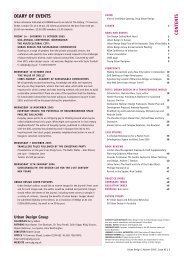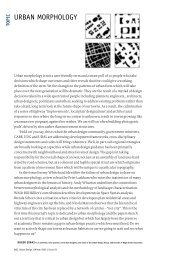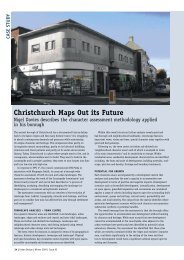CONTENTS DIARY OF EVENTS - The Urban Design Group
CONTENTS DIARY OF EVENTS - The Urban Design Group
CONTENTS DIARY OF EVENTS - The Urban Design Group
Create successful ePaper yourself
Turn your PDF publications into a flip-book with our unique Google optimized e-Paper software.
BOOK REVIEWS<br />
RE-ANIMATING THE WATERFRONT<br />
LIVERPOOL JMU CENTRE FOR ARCHITECTURE, NEARHOS PUBLICATIONS WITH LIVERPOOL JMU, 2003<br />
ISBN 1 901585 03 4<br />
Publications of university project reviews<br />
are a dime-a-dozen. <strong>The</strong> received wisdom<br />
for these works tends to be a jumble of<br />
(usually) seductive, attractive and yet<br />
uninformative images that signal the end<br />
of a certain stage in the student’s career.<br />
<strong>The</strong> book is usually glossy, with a large<br />
number of photographs with favoured<br />
students getting large double-page<br />
spreads and the least popular, relegated<br />
to the odd black and white images – if<br />
they’re lucky.<br />
However, what makes this round-up<br />
of architectural projects from Liverpool<br />
40 | <strong>Urban</strong> <strong>Design</strong> | Spring 2005 | Issue 94<br />
John Moores University different is<br />
the relevance of its subject matter<br />
and commercial awareness, in that has<br />
secured an impressive list of sponsors<br />
that include, key players in the North<br />
West region such as Grosvenor, English<br />
Partnerships and BDP. <strong>The</strong>re is also an<br />
egalitarian approach, with each student<br />
allocated the same amount of space,<br />
showing the importance attached to<br />
each individual’s work.<br />
<strong>The</strong> aim of the projects featured,<br />
which is the regeneration of these<br />
historic waterfronts, is handled<br />
intelligently through a variety of uses<br />
ranging from the practical (mixed use,<br />
retail, office, leisure, transport and so on)<br />
to the bizarre, yet imaginative, such as<br />
Gareth Allison’s ‘Survival training centre’.<br />
Images of the various projects<br />
are mainly vibrant, some are bleak<br />
and hauntingly beautiful (Channel 6<br />
television station – Steven Gallagher) and<br />
others playful and quirky (Magistrates<br />
Court – Berta Willisch), yet all show the<br />
energy and enthusiasm of the students<br />
involved, who have clearly enjoyed<br />
working on what was presumably the last<br />
TRANSFORMING BARCELONA<br />
TIM MARSHALL, ROUTLEDGE, 2004, £27.50<br />
ISBN 0 415 28841 X<br />
Barcelona has rightly become renowned<br />
for the work in remaking the city<br />
over the past 25 years. Visitors often<br />
obtain only a limited impression of the<br />
background to the projects and this book<br />
aims to provide a wide coverage of the<br />
governmental, social and cultural issues.<br />
Tim Marshall has assembled a series<br />
of papers that have in the main been<br />
published separately elsewhere and they<br />
provide a wealth of information. <strong>The</strong><br />
first and largest section containing eight<br />
of their diploma projects before they are<br />
let loose on the ‘real world’. My only point<br />
of contention is that, in general, the<br />
projects are very much ‘architecture writlarge’<br />
and what is presented at the end is<br />
mainly and I suppose, understandably the<br />
‘sexy’ image, rather than the analysis that<br />
went into producing them.<br />
With the amount of press coverage<br />
that has been given over to the<br />
Liverpool waterfront due to the demise<br />
of Alsop’s ‘Fourth Grace’, the subject of<br />
the book is also both timely and topical,<br />
as even now, it is unclear how Liverpool<br />
re-engages with its neglected and partly<br />
forgotten waterfront. <strong>The</strong> book does not<br />
ultimately provide a single real solution<br />
as to how that can be achieved but<br />
shows a myriad of possibilities and more<br />
importantly, engages the interest of the<br />
next generation of built environment<br />
professionals.<br />
I shall scan the pages of BD and<br />
AJ to see what the new generation<br />
of Liverpool architects will do in the<br />
coming years.<br />
Sherin Aminossehe<br />
papers describes what has happened<br />
and the factors seen as important by the<br />
various writers include:<br />
• the outstanding plan by Cerda which<br />
continues to influence the city's layout<br />
• the opportunity taken by the city to<br />
host world events such as the Exposicion<br />
in 1929<br />
• the metropolitan plan approved in<br />
1976 ahead of many areas in Spain which<br />
has provided a basis for later work<br />
• the stable political structure from 1979<br />
• design quality placed high on the<br />
agenda and implemented quickly<br />
• the nomination for the Olympics, and<br />
• the opportunity taken to upgrade<br />
infrastructure and reorient the city to<br />
the sea.<br />
Pasqual Maragall, mayor from 1982-97,<br />
contributes an important chapter making<br />
the case for a special charter for the city<br />
(which was never achieved,) and also<br />
relating the city and its metropolitan<br />
area to Catalonia and Spain although<br />
seeing the city as a capital crossing<br />
national boundaries. Oriol Bohigas<br />
provides ten points for an urban<br />
methodology, previously printed in the<br />
AR, but I found the terminology a barrier<br />
and it needed translating to friendlier<br />
but useful terms - many of which are<br />
similar to New <strong>Urban</strong>ism ideas.<br />
<strong>The</strong> second section includes two<br />
papers on present and future projects<br />
which include areas adjacent to the two<br />
rivers, as well as the Diagonal, Poblenou<br />
and the Waterfront, part of which is the<br />
2004 Forum development.<br />
<strong>The</strong> last section provides a critical<br />
perspective of what has happened from a<br />
social, design and ecological viewpoint.<br />
<strong>The</strong>re are many lessons to be learned<br />
from Barcelona and the book provides a<br />
useful summary of the major issues. It is<br />
significant that Maragall is an economist<br />
and had previously worked for the<br />
city council. Many of the contributors<br />
have also served as councillors and are<br />
or have been involved in teaching in<br />
university courses. One could argue that<br />
this cross fertilisation is something that<br />
distinguishes Barcelona from most UK<br />
comparisons with distinctive effect.<br />
John Billingham







